Module 18-abundance and distribution
Start with this:
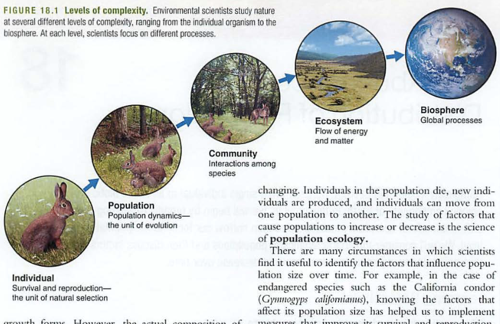 |
|
Click for full-size image |
We covered ecosystem energy and matter a few weeks ago, this chapter is about population ecology.
--------------------
Quiz: 10.16.19:
- What three things in order are necessary for evolution to succeed?
- What are the characteristics of an r specific species. Give an example.
- What are the characteristics of a K specific species. Give an example as well.
- The population of wolves may rise and fall along with rabbits, but not at the same time. Explain why.
--------------------
Population dynamics
Notation: Pop size is represented as N (note not "n"): population size within a defined area at a specific time (brings in migration).
Check out the diagrams on pop distribution: random, uniform and clumped. Important vis a vis biodiversity
Structures: age and gender (sex)
Density dependent factor: e.g. food or reproductive rate in rats (more rats, lower fecundity)
Something that influences reproduction or survival...
Density IN-dependent factors: storms, disasters, fires (note density independent: one bambi or 100 bambi all perish in the same fire)
Limiting resource: usually food, but could include space, nutrients, etc.
Carrying capacity: K (note not "k"): how many individuals an environment can support
Module 19: growth models
Check this out:
This is called exponential growth, or "J shaped growth"
Note that it has no end, or limiting factor.
Small r is the growth rate. If you have had physics (yay!) this is usually "k" in some examples, or related to RC decay/growth.
Learning this equation is VERY useful.
Note that it depends on two things: the amount in the population (No) and the growth rate (r)
Here is an example:
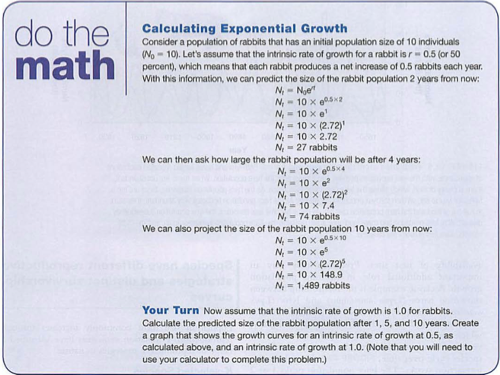 |
|
Click for full-size image |
Many systems follow J shaped exponential growth until they run out of food or space, then there is overshoot and die-off. A more ideal version of this is the S shaped curve, called logistic growth:
Here is a formula for logistic growth that we'll discuss:
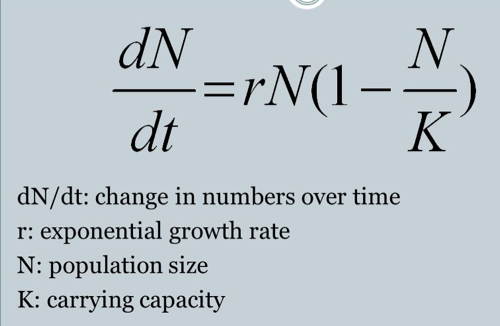 |
|
Click for full-size image |
dN/dt is just the rate of population growth (some of you may see this as the slope of the S curve)
Note that when the ratio N/K is very small, the parentheses become 1, so the formula is rate = rN
As N/K nears one (number of critters equals carrying capacity) the term in the parentheses becomes zero, so no growth.
Note also that if N/K is GREATER than one, the growth rate (slope of the curve) become negative. This is overshoot and die off.
------
Logistic growth worksheet
First: exponential growth:
Imagine 10 imaginary rabbits (No=10)
Assume r = 0.5 (50 percent growth rate, or each rabbit makes 0.5 rabbits per year)
Find the population 2 years later:
Nt = Noe^rt
Nt = 10e^0.5*2
Nt = 27 rabbits
After 4 years:
After 10 years:
———
Next, use the logistic growth formula, same data, with a carrying capacity (K) of 100:
Small population: 10 rabbits
∆N/∆t = rN(1-N/K)
= 0.5*10(1-10/100)
= 5(1-0.1)
= 5(0.9)
= 4.5 rabbits per year
Find the rabbits per year for these populations:
Medium population: 27 rabbits
Near K: 74 rabbits
Above K: 1489 rabbits
You can use the Apple Grapher app to see this (look in your Utilities folder):


Quiz: 10.17.19
10.17.19 quiz (you may use your worksheet from Wednesday)
- 30 rabbits live on an island with carrying capacity 200. They reproduce at a rate of 0.5 per year. How many rabbits will be on the island after 3 years?
- What will be the slope of the growth curve at this point?
Next: predator/prey phase diagrams
Check this out:
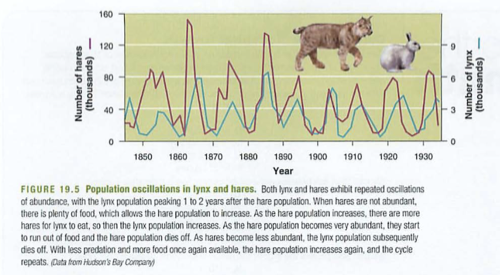 |
|
Click for full-size image |
Note the phase (timing) relationship between the abundance of the food and the population of the prey, then the predator.
Predator Prey Lab:
Worksheet: (uses Numbers application)
Worksheet: excel version:
Questions:
Now we can discuss generalizations of r and K strategists:
Where do you fit in? How about Nemo?
There is a fourth: deer. How would you imagine this curve?
Related:
I just learned last week another reason why genocides are so damaging to cultures: If an oral tradition (e.g. Hawaiians) are decimated by smallpox for example, it is the very old (the holders of the legends and history) and the very young (those who have time to listen, not work, and will then grow up and tell their kids) that are gone. This is a sort of cultural bottleneck...
Next:
Module 20: Community ecology
Competitive exclusion principle: two species competing for the same resources cannot co-exist, leads to...
Resource partitioning: time, space, type of food (one species picks one, the other survives)
Relationships:
Predation: predator and prey, one lives, the other dies
Symbiotic:
Mutualism: both benefit
Commensalism: one benefits, no harm to the other
Parasitism: one benefits, harm to other
keystone species vs. indicator species
Keystone species-many others depend on it
Indicator species-signal health of a system
Succession: one species takes over another in time
Module 21: Community Succession
Primary succession: From bare rock, no soil: (e.g. lichen)
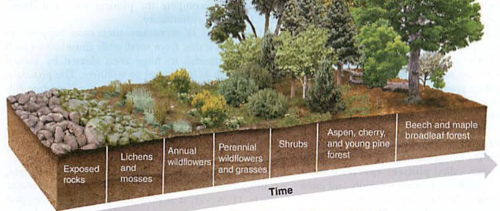 |
|
Click for full-size image |
Secondary succession: from disturbed area with soil (e.g. after a fire)
Pioneer species: arrives first, sets up reliable system
Aquatic succession: from stream to pond to shallow pond to marsh
Island biogeography (like here in Waimea): habitat size AND distance from others influences diversity (e.g. birds)
Check out an alternate presentation of these in the Withgott text, with a special section about our island:
http://physics.hpa.edu/physics/apenvsci/texts/withgott/withgott%206e/3-4.pdf
Frog book chapter 5:
 |
|
Click for full-size image |

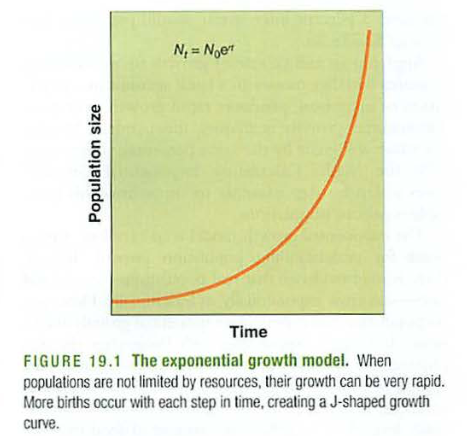

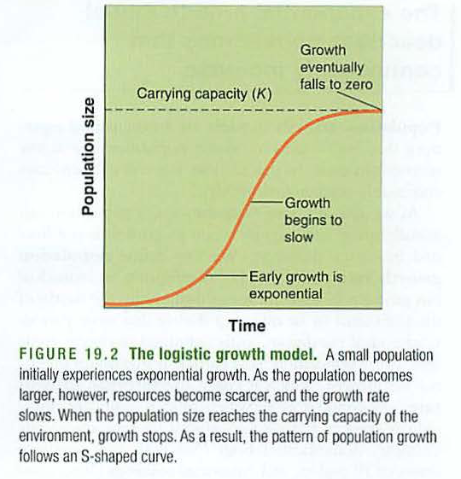









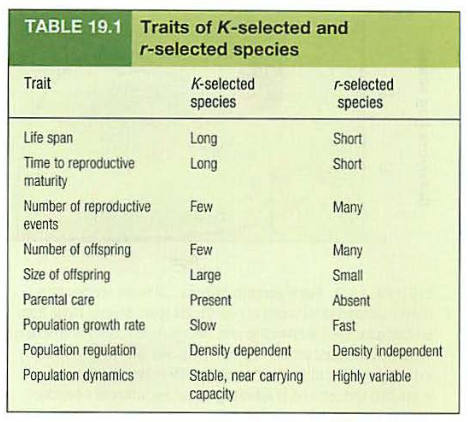
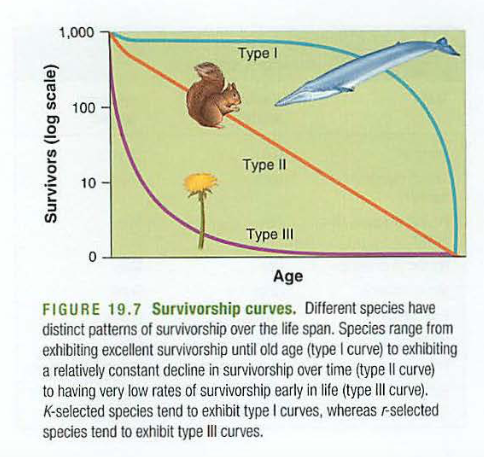
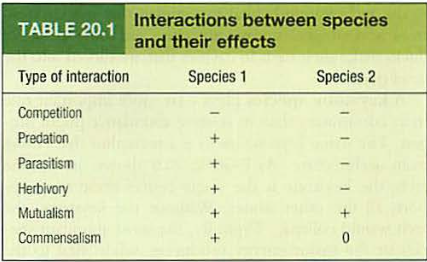


Comments